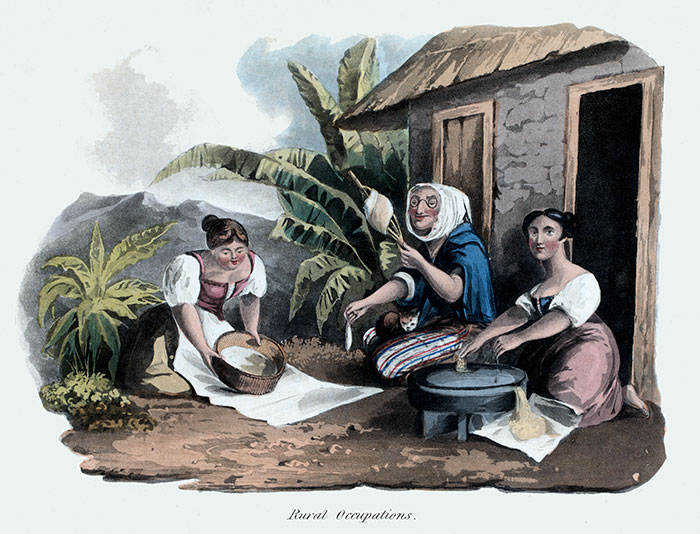engraving and text extracted from
History of Madeira - 1821 (from my library)
Madeira was then under British domination
Female peasants grinding corn
The labour here represented is attached to the grinding of Indian corn, which, though not a native produce, is a chief article of sustenance among the labouring classes. One of the females is grinding the corn by the power of a stone, which the plate fully represents, while the other is employed in sifting it.
When the peasants go into the mountains to cut wood, they carry a sufficient quantity of this food, cooked and cold, which furnishes the necessary meals. They are a very abstemious race of people, and are known to enjoy an excellent state of health : indeed, they generally die of what may be called old age, notwithstanding the severity of that laborious life to which they are subject. Their women, as is here represented, continue to spin, with the aid of spectacles, though they do not always want them, to the extremity of life, of which the plate gives a picturesque example.
The women grinding corn in the open air is a species of labour well known in the remote ages of antiquity. In India, where the antiquary looks for the most ancient manners and customs, this labour still prevails ; and Scripture itself mentions it as familiar to the evangelical age. Among other signs of the end of the world, it is
mentioned in St. Matthew, c. XXIV., v. 40, 41, “ Then shall be two in the field, the one shall be taken, and the other left. Two women shall be grinding at the mill, the one shall be taken, and the other left"
If with attentive eye we trace
The progress of the human race,
We find that man's first social state,
Before he thought of being great,
Was by hard labour and by toil,
To hunt the woods, to till the soil ;
And all the human frame sustain’d
Was by its daily labour gain’d ;
The women, too, were known to share
The hardships of domestic care.
The Patriarch’s daughters, Scriptures tell,
Water’d the cattle at the well,
And ground the corn, as we now view
Madeira’s female peasants do.
Thus while with curious eye we see,
This scene of ancient industry,
We bless the means by which the power
Of urging the laborious hour,
Is given to every aged dame
By arts of later times to claim ;
For ’tis to them that old age owes
The power to see beyond its nose.
The costumes:
The two young peasant women wear the classic laced corset dress in light brown, while the old lady has her head wrapped in a scarf, and keeps warm with a small blue jacket, and as a sign of distinction, her dress is striped.


![]()














